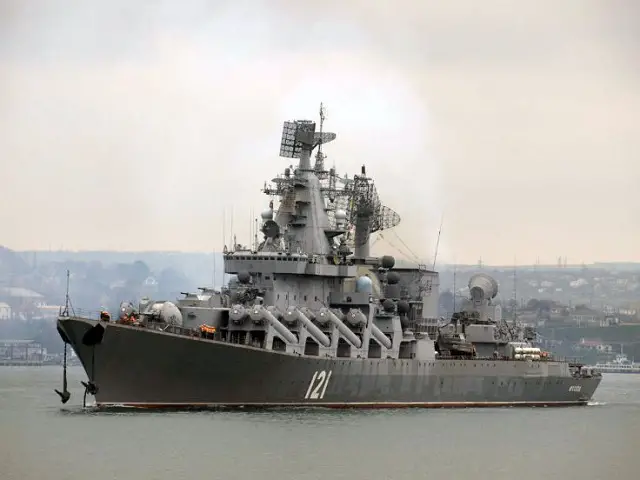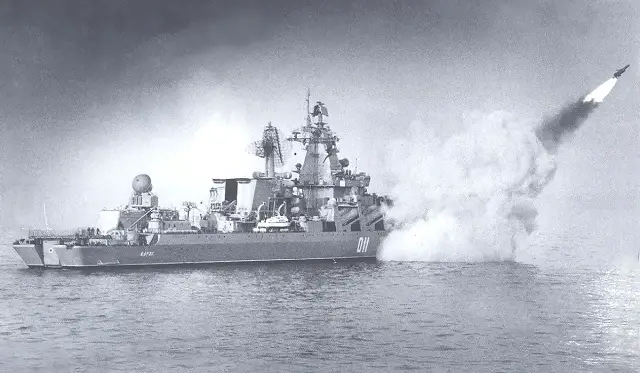Comparison: Russian Navy Slava-class and US Navy Ticonderoga-class Cruisers in Combat
 Project 1164 Atlant (Slava) class cruiser Moskva, flagship of the Russian Black Sea Fleet |
|||
Slava-class
The Project 1164 Atlant-class Moskva missile cruiser has a total displacement of 11,500 tons, a length of 186.5 m, a complement of 510, a full speed of 32 knots and a range of 6,000 nm. The Moskva is currently being modernized and repaired which should extend the life of the ship until the end of the 2020s. Another vessel of the same class, the Marshal Ustinov has just been refitted. Her main armament is the P-1000 Vulkan missile system with an ammunition load of 16 cruise missiles with a maximum range of 700 km. Her main air defense (AD) armament is the Fort (S-300F, NATO reporting name: SA-N-6) surface-to-air missile (SAM) system with 64 SAMs, which range stands at 90 km. The ship’s self-defense AD assets are two Osa-MA single-channel SAM systems and three batteries of AK-630 close-in weapons systems, two AK-630s each. The cruiser’s antisubmarine warfare (ASW) weaponry comprises two five-tube torpedo launchers and two RBU-6000 antisubmarine rocket launchers. The versatile artillery systems include a 130-mm AK-130 two-barrel automatic gun. The ship features effective electronic warfare (EW) equipment to jam enemy aircraft electronics and the seekers of incoming antiship missiles. The cruiser can accommodate a Kamov Ka-27 (Helix) helicopter. According to Western expert estimates, sinking or badly damaging a ship like that would take four to six hits of Harpoon antiship missiles or two to three Tomahawk missile hits. |
|||
Ticonderoga-class Guided Missile Cruiser USS Cowpens launching two surface to air missiles US Navy picture |
|||
Ticonderoga-class
The USS Port Royal (CG-73) Ticonderoga-class cruiser has a total displacement of 9,800 tons, a length of 172.8 m, a crew of 387, a full speed of 32 knots and a range of 6,000 nm. As is the case for the Russian class of cruisers, the Ticonderoga-class is also undergoing a modernization program. The cruiser carries various missile systems in two below-deck Mk 41 versatile verticals launch systems with a total capacity of 122 launch tubes. Her standard ammunition load is 24-26 Tomahawk cruise missiles, 16 ASROC antisubmarine missiles and 80 SM-2 SAMs. In addition, the ship carries 16 Harpoon antiship missiles in deck-mounted launchers and is equipped with the Aegis combat system. The cruiser’s versatile artillery systems are two 127-mm Mk 45 automatic guns. Her ASW weapons include two three-tube torpedo launchers for using Mk-46 small-size antisubmarine torpedoes. The USS Port Royal features extremely effective sonars and two ASW helicopters. From one to three Russian heavy antiship missiles would be needed to sink the cruiser or render it inefficient. Eliminating a US aircraft carrier would take three to seven missiles. To learn more: Link to Ticonderoga class guided missile cruiser technical datasheet |
|||
 A P-1000 Vulkan missile is launched from missile cruiser Varyag in 1994 |
|||
The best way for the Moskva to hit an aircraft
carrier is to come within the range of her antiship missiles and fire
off a salvo. In such a case, she will certainly deliver a strike against
the main body of the carrier strike group (the carrier and three or four
screening ships), other conditions being equal. A 16-missile salvo will
be countered with multichannel AD systems, fighters on combat air patrol
and EW systems. As many as two missiles can be downed by the fighters.
The enemy formation’s total AD capability (7-8 to 10-12 units) will
eliminate 70-80% of the remaining incoming missiles. The EW gear will
reduce their hit probability by 50-60% more. Thus, one or two missiles
will reach the carrier at best, i.e. the salvo’s probability of
rendering a carrier inefficient equals 0.2.
In a meeting engagement, the Moskva’s chances for hitting the carrier will be much more poor, maybe, nonexistent at all, because the carrier will not allow the Russian cruiser to get within range for a salvo (for this reason, submarines and naval bombers will play the key part in dealing with CVBGs, by the way). The Russian cruiser will be far more effective against surface action forces. Attacking a surface strike force of 2-3 destroyers and guided missile frigates, she can render inefficient or send to the bottom of the sea up to two enemy ships while being invulnerable to them owing to her longer-range weapons. A strike against an amphibious landing task force or a convoy will destroy three to four of the ships, i.e. the Moskva’s combat effectiveness in a battle like that is estimated at 0.3-0.5. The effectiveness of the Moskva’s AD assets against an attack of a hostile air squadron or a salvo of 12-16 Tomahawk missiles is estimated (based on open source data) at 0.3-0.6 depending on the type of enemy weapons encountered. The Moskva will use its Vulkan cruise missiles to attack land-based targets. In this case, the hit probability is estimated at two to three point targets out to 600-650 km inland. Since the purpose of such attacks is to disrupt an AD or command and control system in a specific area in particular, the effectiveness of the attack should be compared with the overall number of the targets subject to elimination. If they are the above-mentioned sophisticated systems, there may be 20 or more point targets even in a limited area. Hence, the efficiency of the attack is estimated at 0.1 or lower. The Moskva cruiser’s ASW capability is estimated based on her ability to destroy a submarine before the latter gets within range for a torpedo salvo. This index is hinged on many factors, of which the principal one is the target acquisition range of the cruiser’s sonars. Taking into account this set of factors, the military expert estimates the Moskva’s ASW capability at 0.3-0.6 depending on the hydro-acoustic conditions and the class of the submarine. |
|||
Tomahawk Launch aboard the U.S. Navy’s Ticonderoga Class cruiser USS Shiloh. US Navy picture |
|||
The same estimate for the USS Port Royal is
as follows. As far as the elimination of surface forces (surface action,
amphibious landing and hunter-killer task forces and convoys) is concerned,
the estimate is three to four surface ships, or 0.3-0.5. Considering her
more effective sonar system, the Port Royal’s ASW effectiveness
is estimated at 0.5-09, her AD effectiveness at 0.4-0.7 depending on the
types of incoming weapons, and her Tomahawk land-attack missile effectiveness
at six to eight point targets out to 1,000 km inland, i.e. 0.2.-04.
In a duel engagement with other things being equal, the probability of the Moskva’s damaging or sinking the Port Royal from a standoff range owing to the longer reach of her weapons is estimated at 0.5-0.7 If the two ships detect each other within the range of the Port Royal, the latter’s chances for survival are higher. However, the probability of this scenario is negligibly low. To get within attack range, the US cruiser will have to approach the Moskva while being within her range for several hours. Conclusion The analysis has yielded an integral index of the two ships’ fitness for their purpose. The Russian cruiser’s index is 0.23 as applied to local wars and 0.28 to large-scale ones. The US cruiser’s index is 0.39 and 0.52 respectively. Hence, the Russian cruiser lags behind her US rival by about 40%, but the Russian ship will beat her opponent in a duel engagement owing to a considerably longer range of her weapons. The primary reason for this is that the Moskva is more specialized as a strike ship designed to deal with large surface forces. Her ability to accomplish her main mission - defeat a carrier strike group - is not very high, while the Port Royal is more versatile and designed to handle a wide range of missions relevant in a wider spectrum of scenarios. © Copyright 2015 TASS. All rights reserved. This material may not be published, broadcast, rewritten or redistributed. |
|||


























